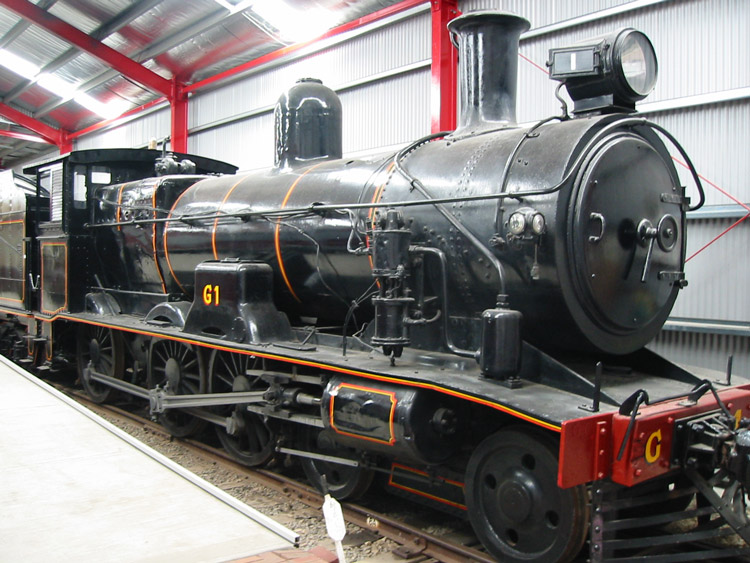
|
G 1 Federation Engine |

G 1 displayed at the National Railway Museum, Port Adelaide on 24 September 2005.
|
The Trans-Australia Railway was created as a result of Australia's Federation following a promise to link Western Australia to the Eastern States via a railway across the harsh and waterless Nullarbor Plain. The Trans-Australia Railway was completed in 1917, despite the demands of World War 1, providing a standard-gauge link between Port Augusta, South Australia and Kalgoorlie, Western Australia. The choice of standard gauge for the Trans-Australia Railway initially created break-of-gauge transfers to 3' 6" gauge railways at both Kalgoorlie & Port Augusta, but in subsequent decades the standard gauge has progressively expanded across Australia and now links all state capital cities excepting Tasmania. (Alas the spread of standard gauge across Australia continues to create break-of-gauge issues, often isolating feeder secondary and branch lines in its wake.) To operate the tough Trans-Australia Railway, the Commonwealth Railways adopted the pragmatic strategy of copying proven locomotive designs rather than risking taxpayers money on new designs, a decision which perhaps also reflected a spirit of Federalism. For the Passenger / Mixed duties, Commonwealth Railways specified their G-class to the same design as New South Wales Government Railways (C)32 class with some minor modifications, such as an enlarged tender coalspace to provide sufficient fuel for the long stretches between coal stages across the Nullarbor. (Preserved NSWGR (C)32-class locomotive 3265 makes for an interesting visual comparison with G 1.) A brief summary of the main locomotive steam types to work the Trans-Australia Railway follows:
Other interesting locomotives to work on the Trans-Australia Railway were:
The Commonwealth Railways quickly converted Trans-Australia Railway operations to diesel traction in the early 1950's, an easy decision given the extraordinary cost of steam power, owing to the distance from suitable coal supplies and the very poor water quality from bores across the Nullarbor. The Commonwealth Railways scrapped most of their steam locomotive fleet in the 1950's and the remaining engines (including the handsome C-class 4-6-0's) succumbing at Port Augusta in the early 1960's. G 1 was built by Clyde Engineering, Granville (builder's number 126 of 1914) and was assigned to construction train duties prior to opening of the Trans-Australia Railway in 1917. It seems the Commonwealth Railways recognised the historical importance of this engine as it was stored in the Port Augusta carriage shed for many years following its withdrawal from service in 1945. G 1 finally found a suitable home when it entered the Mile End Railway Museum in December 1969. (It is paired with a high-sided K-class tender; presumably it was paired with this tender during the final stage of its working career.) The Mile End Railway Museum was superceded by the Port Dock Station Museum, Port Adelaide in 1988 and G 1 and the other Mile End exhibits were transferred there in 1988. G 1 is now the central exhibit in the Commonwealth Railways hall of the National Railway Museum. Given that G 1 is the only steam survivor from the Trans-Australia Railway, it perhaps could be considered as Australia's "Federation Engine" symbolising the fulfilled Federation promise to link with Western Australia via a Trans-Continental Railway. For a comprehensive and detailed history of the Commonwealth Railways motive power, I recommend the authorative publication 'Locomotives and Railcars of the Commonwealth Railways' as referenced below. Chris Drymalik also provides a detailed history of all Commonwealth Railways locomotives on his excellent Comrails site. |
References
|
a |
Fluck, R, Marshall B, Wilson J & others, 'Locomotives and Railcars of the Commonwealth Railways' published by Gresley Publishing, South Australia for the Port Dock Station Railway Museum, 1996. |
|
b |
Fluck R. E., Sampson R., & Bird K. J. 'Steam locomotives and Railcars of the South Australian Railways', published by The Mile End Railway Museum (SA) Inc, 1986. |
|
c |
Wilson, J. 'The Mile End Railway Museum, the first ten years', published by the Australian Railway Historical Society (SA Division) Inc., 1974. |
Page updated: 18 January 2015